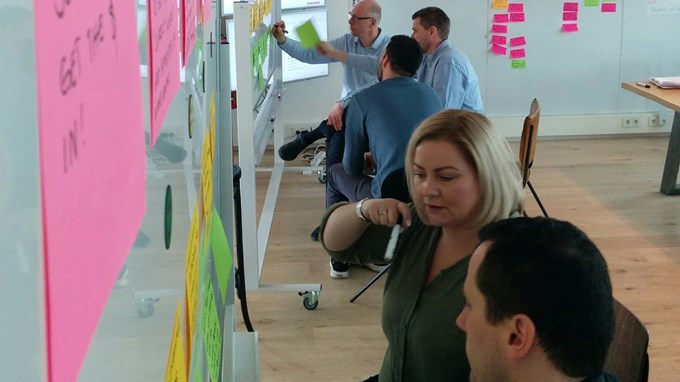MacGregor experimenting with Google’s Design Sprint for rapid validation
20 5月 2019 阅读时间 计算文字
Imagine how much work you could get done if there were no distractions for the duration of an entire week. A whole lot, thought the oPOS team, when they were encouraged to experiment with Google’s famous Design Sprint approach.
For an entire week, phones and laptops were banned as the team engaged in a disciplined design sprint process. Design Sprint, typically a five-day workshop, delves into critical business problems through design, prototyping, and idea validation with customers. The critical business problem that the oPOS (offshore Planning and Operations Support) team wanted to tackle was inaccurate predictions in offshore lifting operations to determine whether data-driven insights could improve the operational window and efficiency.
Instead of stretching the idea development over months or years, the approach squeezes early stage discovery into only one week. To ensure progress, the sprint typically gathers all the relevant experts and decision makers around the same table. That is why the oPos team not only consisted of a business owner, technical experts and UX designers but also five customers - the real experts of their own processes.
So how did it work?
The oPOS team followed a structured process of five phases: Understanding, Diverging, Converging, Prototyping and Validating, facilitated by Connext Lab based in Rotterdam, The Netherlands. During the first three days, many exercises were conducted to understand the customers’ problems and needs. Among other things, the team created user personas and journey maps, job stories and story boards. At the end of the fourth day, the team had created a prototype and a long list of assumptions about the customer problem.
To test these assumptions, the team travelled to Stavanger, Norway on Friday - the fifth day of the sprint. In order to understand customers’ operational reality and receive feedback on the prototype, a full day was spent interviewing 5 users who were able to provide valuable insights on their ways of working. To the great joy of the team, the users loved the prototype and shared some great tips on how to further improve it.
Focusing to find user value with a speed
According to Director of Connext Lab, Jeroen Kraak, the benefits of running these type of workshops are three-fold for large technical corporations like MacGregor. “First of all, the sprint allows looking at the problem from a user's perspective," he explains. “Secondly, the approach can be seen as an insurance plan for investments; in only 5 days you can present your customer with a prototype and test the response validating your assumptions,” he continues. This prevents you from spending lots of time and money on a product or service your customers are not willing to accept.
“Finally, the compressed speed of the process and the 100% focus on the problem with a dedicated team of specialists can spark a new way of working, which allows you to go faster and further than the competition in a fairly conservative industry” he says. By working in a focused manner under some pressure, the team was able to identify areas of opportunity to create customer value in just one week. By using this approach, which has proven to be successful in other industries, MacGregor demonstrates forward thinking and a willingness to experiment with new innovation processes. This also strengthens relationships with customers and creates a lot of positive internal energy.
But how did the team experience the process?
Håkon Jørgensen describes the team’s design sprint as a “rewarding but intense experience that truly challenged the team.” He continues: “The process very much brought us together”. Although decision-making in such a short time span was challenging and sometimes even created friction, the results were fruitful. “The team embraced this challenge and handled friction in a very professional way” Håkon says proudly. “Everyone was exhausted but had a big smile on their face” he concludes. Encouraged by the findings of the design sprint, the oPOS team will continue the development and start delving deeper into the commercial aspects.
Thank you for the wonderful work for all the participants: Håkon Jørgensen, MacGregor’s Director of Digitalisation; Lene Stray, MacGregor’s Sales and Marketing Manager; Eivind Gimming Stensland, MacGregor’s Director, Research and Development; Roar Støbet Lande, MacGregor’s Engineering Manager and Jan Krebber, Cargotec’s Chief UX Designer. And from Connext Lab, Director, Jeroen Kraak, and UX Designer, Vincent Olislagers.